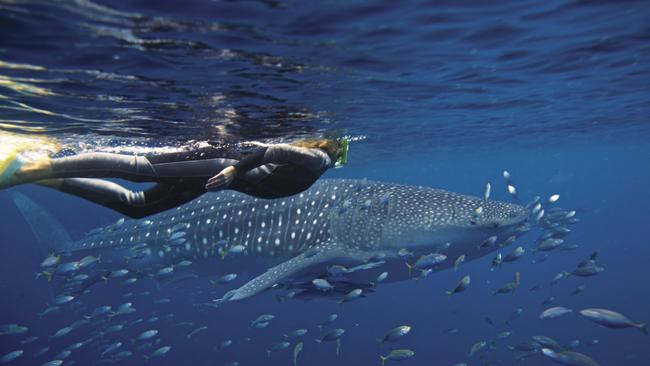The tourist attraction you should bypass in the Philippines
THE Philippines is fast becoming a favourite for Aussies, but there’s one experience you should leave off your bucket list.
IT WAS well before sunrise when the roosters woke us up, getting us ready for what many label the best experience in the Philippines.
Walking down a dirt road towards the small, rocky bay, the carpark starts swarming with minibuses. It isn’t even 6am yet but the tiny registration building is already full of tourists, excitedly muttering about how they’re about to swim with the world’s biggest fish, the whale shark.
Before heading out to see the gentle giants, we’re sat down and given a briefing by a worker at the centre.
She tells the 30 or so of us we’re not allowed to touch, pat or grab the fish. We should also wash off our sunscreen, if we put any on, and to not use flash photography. We should also stay at least 5m away from any part of the whale shark.
In groups of 10, we’re helped into tiny canoes and paddle a quick 10-20m off shore.
Surrounding us are men in smaller canoes wearing bright, blue T-shirts holding handfuls of krill and prawns.
Then, as quick as it took to get us out there, we’re told we have half an hour to snorkel with the fish so we’d better get in the water quick smart.
As soon as you jump in, it’s easy to see why swimming with whale sharks is such a popular thing to do.
They’re huge — most whale sharks grow to 15m in length — and they gently swim past you as they filter litres of water to grab the krill the workers litter the water with.

Despite being warned in our briefing that breaking any of the rules could result in a fine or even jail time, as soon as the swarm of tourists jump in, any law and order seems to go out the window.
Some tourists have a quick look around before swiping or even grabbing the whale sharks while others, who clearly aren’t very strong swimmers, accidentally kick or hit the fish.
Even the locals seem to realise most tourists don’t follow the rules.
“You can always just touch them and if a guide sees you do it just say it was an accident,” one local said the night before our swim.
The 5m rule also doesn’t seem to hold much weight. Not only is the water packed with other people you’re constantly trying to avoid, the guides in the blue shirts throw krill as near to swimmers as possible, coaxing the whale sharks closer and closer.
Clearly, they’re trying to give tourists the best experience possible but it also means swimmers are constantly centimetres away from the giant fish.
The guides in the blue shirts even rest their feet on the mouths of the whale sharks if they come too close to their canoes, gently nudging them away with their feet.
It’s incredible to see them that close but one swimmer next to me seems to sum it up perfectly.
“Where’s the challenge?” she asks.
We’ve all headed to the beachside village (or barangay) of Tan-awan, 10km south of Oslob town.
Oslob sits at the southern end of Cebu, a central Philippine island that is fast becoming one of the country’s biggest drawcards.
Aussies are flocking to the island in droves not just for its white sand beaches and crystal clear waterfalls but because it’s also one of the easiest places in the world to see and swim with dozens of whale sharks.
And while seeing and interacting with whale sharks in the wild might be an ultimate bucket-list experiences, it is best to do it elsewhere.
Since 2011, when whale sharks first started migrating along the coast of Tan-awan, tourists from all over the world have flocked to the small bay to swim or dive with the fish.
It’s also the only place in the world where tourists have a 100 per cent chance of swimming with whale sharks. Why? Because they’re fenced in and fed for hours to keep them there.
While those working for Oslob’s whale tourism industry aren’t openly cruel to the animals, it’s difficult to shake the feeling that these once wild fish are no longer independent creatures of the sea.
Local estimates put Oslob’s whale shark population at around 14, all of which seem to be completely dependent on their daily feeding session from the fishermen.
The fish usually migrate around the world however the whale sharks that come to Oslob are regulars, each noticeable from their unique markings. It’s easy to see these whale sharks have become dependent on their morning feedings.
But Oslob isn’t the only place in the world tourists can spot or swim with whale sharks.
The gentle giant can be seen in other locations in the Philippines, such as Donsol, and can even be seen off the coast of Western Australia when they migrate through the state’s Ningaloo Reef every year from May to July.
It’s also a popular attraction there, but one that’s done much more ethically where tourists swim with the uninhibited whale sharks in the open ocean.
Unfortunately, like Thailand’s controversial Tiger Temple or elephant sanctuaries in places such as Indonesia, the whale shark industry in Oslob seems to be all about the money.
In an interview with CNN in 2015, Oslob’s tourism officer Elizabeth Beneloga said the whale shark industry has helped the local economy — in 2014 11,000 people visited Oslob to swim or see the fish.
“Our whale sharks contribute tremendously to Oslob’s income, helping to create much needed infrastructure, jobs, and opportunities for growth with neighbouring municipalities,” she said.
But income and growth aside, something about Oslob’s whale shark tourism industry definitely needs to change — before it ceases to exist.




